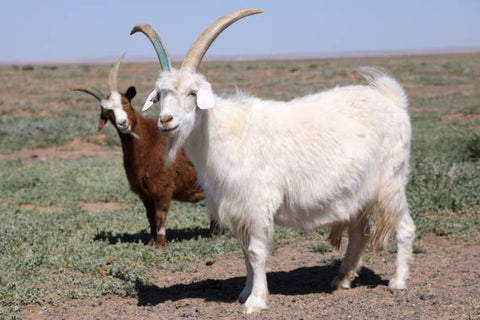ALPACA WOOL VS. CASHMERE WOOL
Alpaca wool and cashmere wool are often compared but they not only come from very different animals they also have different characteristics. Let’s see which ones.
The animals
Cashmere is certainly among the best known and most used wools in the world. It is obtained from the undercoat of the Capra Hircus which lives in the mountainous areas of southern Asia, on the Tibetan plateaus, in the Himalaya region and mainly in Mongolia, but also in areas such as Iran, Russia, Afghanistan, Turkey and India.

To protect themselves from the climate conditions, these goats have two coats: one is superficial, formed by coarse hair called “giarre”, and one is closer to the body, composed of a short, thin and very warm fluff, called “duvet”. In the spring, the shepherds first cut the external hair with scissors and then collect the finer part with special long-toothed combs. The fibers of the two goat coats are then separated, because only the duvet constitutes the proper cashmere.
Alpaca wool, on the other hand, is rarer than cashmere. However, it is 7 times warmer than sheep’s wool and 3 times more resistant and much softer and lighter. This silky, soft and resistant fiber has unique thermal properties thanks to the microscopic air pockets. These pockets allow the body to breathe while maintaining a constant body temperature.

Depending on the age, an alpaca can produce 3 to 6 kg of wool per year, so in 30 years of life it produces about 120 kg. Shearing can be done every year in spring, before summer.
Both yarns have the characteristics of being hygroscopic, antistatic, very soft and hypoallergenic, however, comparing the two wools, an alpaca dress is lighter, perspires more, is warmer and more resistant to wear and isn’t pilling. Alpaca wool is also present in nature in many more color variations than cashmere, thus requiring less dyeing.
Increase in the demand for cashmere wool has also increased the number of farms of these goats which in turn has pushed prices and quality downwards. Breeders started to cross herds and, as a result, goats produce more wool, but the fiber is shorter and unrefined. Fabrics not only lose their softness, but are also more likely to pilling. Also, many manufacturers mix cashmere fibers with yarns, often synthetic, to increase the softness of the garment and further lower the price.
The growing breeding of Hircus goats has become harmful to the environment. Their sharp hooves destroy herbs and plants close to the ground. They graze the plants near their roots destroying them. It is an animal that is easily adapted, which is why it has been introduced in different territories far from the area of origin, causing serious damage to ecosystems: in fact, the species has been included in the list of 100 of the most invasive and harmful in the world.
The alpaca, on the other hand, is an animal that does not harm the territory as it grasps the grass without damaging the roots and the cushions that cover the hooves allow the animal to walk on the ground without compromising its integrity. Finally, alpacas consume less water than goats and grow enough wool for four or five sweaters in a year. According to the National Resource Defense Council, four goats take the same amount of time to produce enough cashmere for a single sweater.
A sweater made of baby alpaca wool, in terms of softness and strength, wins over cashmere. Cashmere fibers are four centimeters long, while alpaca fibers measure between eight and twelve centimeters. This means that alpaca fiber garments are more resistant, therefore long-lasting and less prone to pilling effect.
Insulation
Cashmere sweaters will provide you with good insulation, but alpaca has the best insulation when it comes to sweaters. Alpaca wool’s construction provides a hollow core that traps a pocket of air inside it. This means the fiber can warm up quickly and stay insulated longer. It also breathes through these air pockets, effectively moderating the temperature. Cashmere does not have the same fiber structure, therefore, cannot provide the same level of insulation as alpaca fiber.
Exclusiveness/Rarity
There are about a little less than 5 million alpacas used for wool production while there are more than 700 million cashmere goats that contribute to the cashmere industry. This makes alpaca a rarity compared to cashmere. It really pays to be an informed shopper. Your purchase is not only a fashion investment, but it can have an impact on the environment and indigenous communities too. We hope with his information, you’ll make the right choice the next time you go sweater or even gloves shopping
The baby alpaca is the new cashmere!
When purchasing a wool product, it is therefore advisable to choose a garment that can last over time and which also has an eco-sustainable aspect for both the animals involved and the environment. YAPA sweaters are 100% baby alpaca wool, sustainably sources in the Bolivian Andes, traceable from farm to finish and animal cruelty free.
